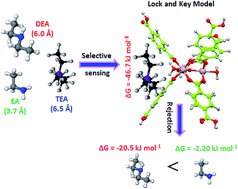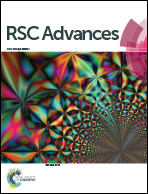Validation of ‘lock-and-key’ mechanism of a metal–organic framework in selective sensing of triethylamine†
Abstract
To develop the metal–organic framework (MOF)-based sensing of triethylamine (TEA) in an aqueous phase, Al-MIL-101-NH2 (MIL: Material Institute Lavoisier) with a tripod-like cavity was utilized based on a lock-and-key model. Al-MIL-101-NH2 (Al-MOF) was found to be an excellent fluorescent sensor for the TEA molecules in the range of 0.05–0.99 mM. The limit of detection (LOD) and linear calibration range of this probe towards TEA were found to be 3 μM and 0.05–0.40 mM, respectively. The mechanism of the sensing process indicates the dominant role of physical processes (e.g., non-covalent bond interactions). In addition, the exact fit of the TEA molecule (6.5 Å) in the tripod-like cavity (6.78 Å) supported the strong interaction between three ethyl groups (TEA) and aromatic rings (MOF). This kind of specific suitability between size/shape of the TEA and tripod-like cavity of MOF (ΔG: −46.7 kJ mol−1) was not found in other molecules such as ethylamine (ΔG: −2.20 kJ mol−1 and size: 3.7 Å), formaldehyde (ΔG: +1.50 kJ mol−1 and size: 2.8 Å), and ammonia (ΔG: +0.71 kJ mol−1 and size: 1.6 Å). As such, Al-MOF was found to be a selective and stable sensor for TEA.



 Please wait while we load your content...
Please wait while we load your content...